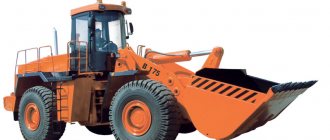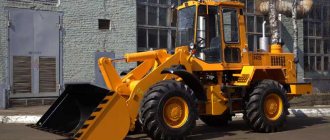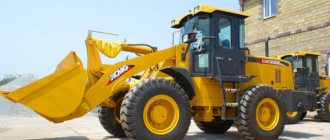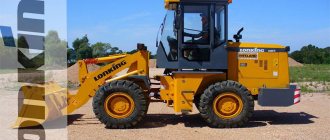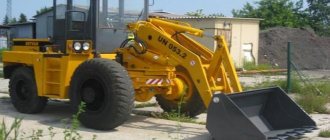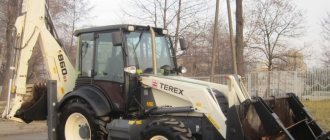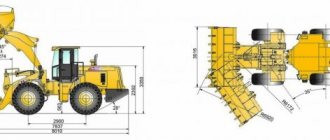When constructing objects for various purposes, special-purpose self-propelled equipment is used. When transporting goods and storing materials, loading and digging, or towing equipment, it is impossible to do without mobile equipment.
A front loader is a vehicle equipped with a device for picking up and moving objects, performing quarry work and towing bulk or piece materials within a construction site. The working mechanism of the loader is a boom with an operating device. Some models are equipped with a specially designed boom, the fastening mechanisms of which can be equipped with hooks, forks, irons for clearing snow from the road, grips, and buckets of various sizes.
The front loader is equipped with hydraulic cylinders, thanks to which the technical unit has the ability to rotate the working element 180° in relation to the boom, rods and rocker arm. During operation, the hydraulic system compensates for the load with technical oil pressure, which makes it possible to determine the mass of the load captured by the bucket.
Loader with weighing terminal
A front-end loader is an indispensable assistant at a construction site. Special equipment with a weighing terminal is especially popular. By connecting the hydraulic cylinder to the pressure sensors, the signal is converted into digital readings and displayed on the display. Working on a front loader with a weighing terminal allows you to monitor the amount of material loaded into the mixing drum or onto the vehicle. The weight of each portion of the product is summed up with previous indicators, and the digital value of the total weight is displayed on the monitor.
Despite the fact that a front-end loader at a construction site experiences heavy mechanical and vibration loads, load sensors are not affected by them. The weighing system, which can be installed on any model of special equipment, is powered from the machine’s electrical network.
Construction
The first thing that comes to mind is construction: road, industrial, civil. It is at construction sites that this equipment fulfills its direct purpose - loading, moving and supplying any bulk materials (sand, gravel, asphalt and others), as well as stacking palletized cargo, for example, bricks, tiles, various mixtures on a pallet.
Loader control
Operating a front loader does not require special training. The driver is provided with a modern control system with prompts. Depending on the design features, the control elements can be located on the panel or on the armrests.
The following controls are used:
- levers;
- mini levers;
- buttons;
- keys;
- joysticks.
The front loader operator works in comfortable conditions; the workplace is located in a cabin, glazed on all sides. Its space provides freedom of action, the shock absorption system reduces vibration levels, and high-quality insulation reduces noise levels. Modern models of construction equipment are equipped with air conditioning and a dust removal system.
Forestry industry
Not a single large timber processing enterprise can do without loaders. They transport logs using special grippers and store finished products. In addition, the forklift participates in electrification. Using a log grabber, he delivers power transmission poles to the desired point, and with the help of a bucket he performs excavation work (digging a hole, leveling the surface).
Specifications
A modern front-end loader, the characteristics of which depend on its design features, is capable of performing a large amount of work in one work shift. As standard, the vehicle weight is 8.4 tons, with an engine power of 120 hp, the speed of the machine on standard tires reaches 20-35 km/h.
With a maximum pressure in the hydraulic system of 279 bar, the pump capacity is 140 liters per minute. The machine's bucket can accommodate a load weighing up to 3500 kg, the tipping load with the bucket is 5.4 tons. The digging depth of the bucket reaches 0.2 m, the tipping angle at maximum height is 52-55°, the grip angle at ground level does not exceed 47° . The bucket lifting time takes 3.9-6.2 seconds. Unloading by tipping occurs in 1.7-2.2 seconds.
Features of choice
The main characteristics for choosing forklifts, in addition to taking into account the specifics and location of activity, are:
- ability to work with different attachments;
- engine capacity;
- cabin comfort;
- maximum working weight;
- width and height of the machine;
- maximum lifting height;
- bucket capacity.
These are the main characteristics for choosing a forklift. In specific work environments, where the maximum load is 2 tons, front-end mini-loaders will do an excellent job of achieving their goals. A 2.5 liter diesel power unit with a power of 100 hp will be sufficient. This model is well applicable for repairing or laying roads in the city, removing snow, loading and unloading bulk materials in small enterprises. For quarries, it is better to use more powerful versions with a bucket capacity of 15 to 30 cubic meters. The engine of such loaders will be 500-1500 hp. and the carrying capacity will be 30t.
Caterpillar and analogues
Caterpillar is the leader in material handling equipment. Due to its worldwide recognition and enormous cost, not every enterprise will be able to purchase this unit. But there are also alternative options. One of them is forklift rental. The benefits of such a solution are multifaceted. For example, the company saves a lot of money because renting is cheaper than buying new or used equipment. Also, taking into account different types of work, you can rent different loaders. So, to send a large consignment of goods, powerful equipment is rented one-time, and for distribution work inside the warehouse, a loader of less power is taken, but for a long time.
Another alternative is to purchase high-quality, but less expensive Chinese equipment from LiuGong. The model range from the Chinese company is quite wide and offers loaders for both light (1500kg) and heavy (8000kg) weights. As a result, the company only needs to employ an experienced driver capable of working on equipment of various capacities.
Popular models
In Russia, on the market for specialized machines, there are models from well-known companies of varying prices and quality. The main manufacturers are:
- John Deere - and its popular K-series loaders;
- Caterpillar - better known around the world as CAT, with its super-strong 994F or "baby" 216E loader;
- HYUNDAI - representing medium-power equipment up to 4-5 tons, a striking example of which is the HL740-7A;
- CASE - with the famous F series of loaders;
- "Amkodor" - with B series equipment, and its prominent representative 342B;
The driver/machinist will be comfortable working in the cabin of any loader listed above, and this directly affects productivity.
It is worth noting that front loaders are used in almost every manufacturing company. Various models of this equipment are used in wood harvesting, livestock farms and other types of agriculture. The equipment of these machines continues to be constantly improved, which contributes to their future use.
Find a reliable dealer
Before gathering information to help you choose a specific forklift model, or at least in parallel with this process, it is recommended to find a good dealer. Considering the cost of the car, not to mention the cost of its subsequent operation, the right choice of dealer can save you hundreds of thousands of rubles over the life of the car.
Long on the market. A highly professional dealer will tell you what technical characteristics a future loader should have in order to most cost-effectively carry out work at your construction site under specific conditions, and will help you select a machine. The easiest way to find a suitable dealer is through recommendations from colleagues. From the list of applicants, it is recommended to select those who have longer experience working with this equipment. Therefore, a dealer who has been in the forklift business for over 10 years may be preferable to one who has only recently specialized in this equipment. Ask your dealer if he can provide contact information for several of his customers who have already purchased equipment similar to what you need, and talk to these customers.
Location . It is recommended to choose a dealer whose service center (or sub-dealer) is located no further than 80 km from the place where your equipment operates.
Education . Many dealers offer courses to teach customers how to properly operate safely, or provide training materials either electronically or online, or can send training instructors directly to the forklift job site. If the dealer you choose offers such training, and even in your territory, it can bring significant financial benefits, save money on travel expenses for employees, gain valuable knowledge and skills, and also avoid accidents with serious consequences.
Financing the purchase. Forklifts are often purchased on lease, and many dealers offer assistance in arranging financing for the purchase. It is still recommended not to rely entirely on the dealer’s employees and to study for yourself at what interest rates and on what conditions various banks provide loans. If you manage to win even half a percent, this will bring significant savings over the entire life of the loan. Do not forget to carefully study all the “fine print” written in the contracts - as experience shows, this is where the most important information for you may be, for example, about the amount of fines in case of late payment. Ask your dealer for as many details as you can about financing purchases.
Local regulations. If you are contracting work in an unfamiliar region, research local laws and requirements that apply to your work and equipment. It is preferable to choose a local dealer who can tell you what regional regulations and restrictions exist and help you obtain the necessary permits from local authorities for the cars sold to you. Before purchasing forklifts, check with your dealer to see what assistance they can provide you with these issues.
After-sales service. Timely and correct performance of regular maintenance by qualified dealer specialists in accordance with the recommendations of the manufacturer is the main condition for the profitability of the machine and keeping production costs low in the long term. Key components—bucket, tires, steering, brakes, and lights—must be inspected by the operator at all times to ensure safe and productive machine operation. Timely replacement of wear parts such as bucket teeth, cutting edges and tires also helps keep production costs down. The service life of the loader and its availability rate depend on the quality of technical support.
It is very important to select a dealer who will help the construction company reduce production costs and machine downtime through prompt delivery of spare parts and consumables, as well as high-quality maintenance. Find out from the dealer how quickly the equipment manufacturer supplies parts that the dealer may not have in stock.
A qualified dealer can advise your company on what parts and consumables should be purchased in advance and stored in their warehouse for prompt use.
Service contract. Service conditions are specified in the service contract. It is difficult to overestimate the importance of this document. Ask your dealer what types of service agreements they offer. When signing a service contract, pay attention to the following points.
The parts and supplies used to service your forklift should be from reliable brands. If, in the absence of branded spare parts, replacement with some other brands is intended, this must be stipulated in advance in the contract.
The intervals for basic standard maintenance, additional service (on various systems), and maintenance of all other components of the lift truck, from the bucket to the rear bumper, must be specified. A price list with prices for work and spare parts must be attached to the contract.
The contract should specify the service center's operating hours and where to go (and what assistance can be obtained) in case of an emergency outside of normal business hours. If the dealer does not provide 24/7/7 days a week service, the contract should specify how quickly assistance will be guaranteed after the first day of business.
The warranty must cover all parts and labor.
Your responsibility is to ensure that the dealer strictly adheres to all clauses of the service agreement, since the profitability of operating the forklift depends on their implementation.
